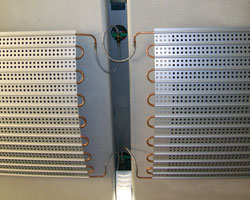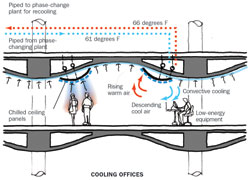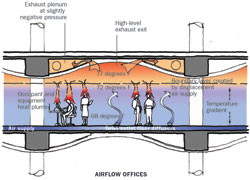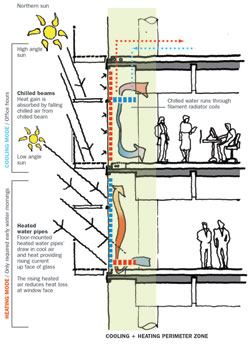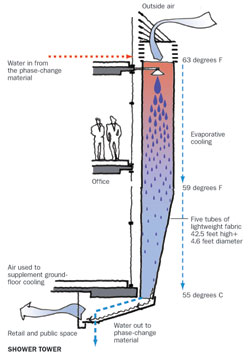Architecture, Hot and Cold
The original plan for CH2 called for a naturally ventilated building, but Wall says once it became clear that the building would need to meet the highest standards for occupant comfort when compared to commercial offices in the local market, they decided against natural ventilation because of noise and air-quality concerns in the busy central business district location. Instead, to maintain 75 degrees Fahrenheit in the building, the designers embraced a combination of passive and active HVAC systems. This meant the floor plate−with a width of nearly 69 feet−was not as narrow as originally proposed (a narrow floor plate assists in cross-ventilation), but it also meant the designers needed to take a more holistic view of how the HVAC systems would be integrated into the structure and architecture.
|
||||||||
The Sum of All Parts
The success of that integration is felt every day. Consider an operational profile of the building on a warm day−Melbourne's temperatures average 80 degrees F in January−as experienced by an occupant sitting at her desk in the open office plan of the sixth floor. The building's concrete structure, poured with 30 percent fly ash, and its wavy, 7-inch-thick precast-concrete ceiling panels both cool down when windows automatically open from 1 to 6 a.m. to allow in night air. This lowers the office's temperature 4 to 5 degrees and is directly responsible for a 14 percent energy savings for cooling. The ceiling is wavy for two reasons: first, to increase the surface area of thermal mass, and second, to create cavities used for exhaust air. Wall says they researched laser etching the concrete ceilings to double the surface area, but it proved too expensive (although, analysis showed it would have significantly improved the thermal properties). However, the ceilings are sandblasted, which does increase surface area.
Once the occupants arrive in the morning, air-handling units on the roof kick on and supply filtered, 100 percent outdoor air to cast-concrete ducts running down the building's south elevation. These ducts tie into the 6-inch, pressurized cavity of the raised floor on each level. "That's quite tight compared to most access floors," Wall says, a decision he says was made in order to preserve market-rate floor-to-floor heights of nearly 10 feet. The air, which is treated for humidity depending on the wet-bulb temperature of the outdoor air, enters the space via floor-mounted, user-controlled "twist" diffusers at each workstation. This cool air heats up and rises through the space and, induced by the stack effect, is pulled into slots along the ceiling panels and into cavities where it exhausts into shafts designed into the north elevation. These shafts exhaust through rooftop-mounted wind turbines. Matthew Jessup, a principal at Lincolne Scott, says computational fluid dynamic (CFD) modeling−and, now, postoccupancy studies−illustrate that this combination of night flushing, thermal mass, and mechanically supplied fresh air has been more than enough to keep occupants cool the entire morning and, on milder days, well into the afternoon.
|
||||
During warm afternoons, however, the building shifts from a passive mode (where outside air is simply moved around) to an active mode that depends on mechanical cooling. The most novel aspect of CH2, in this respect, is the use of radiant panels attached to the underside of the precast-concrete ceiling units. Mechanical engineers like to call this a "chilled beam" or, in some cases, a "chilled ceiling." Long a solution embraced in Europe, chilled beams have yet to significantly catch on in the U.S. or Australia. For a conventional installation, the beams, which are basically metal tubes, are filled with chilled water supplied by a central chiller. "Using water as a medium for cooling is much more efficient than moving cold air around the building," says Wall.
At CH2, the beams are supplied with chilled water from two sources: an innovative phase-change-material-based storage tank in the basement and a more conventional rooftop central plant consisting of a gas-fired cogeneration plant. Phase-change materials (PCMs) are natural compounds, generally salt-based liquids, that collect and then release energy. This typically occurs from a liquid to solid state and vice versa. PCMs are basically a more efficient version of ice storage, where engineers have taken advantage of cheap energy at night to make ice, which can then be melted during the day to provide chilled water to a building. And it's much more efficient when compared to Pearce's original concept of using rocks for thermal storage.





